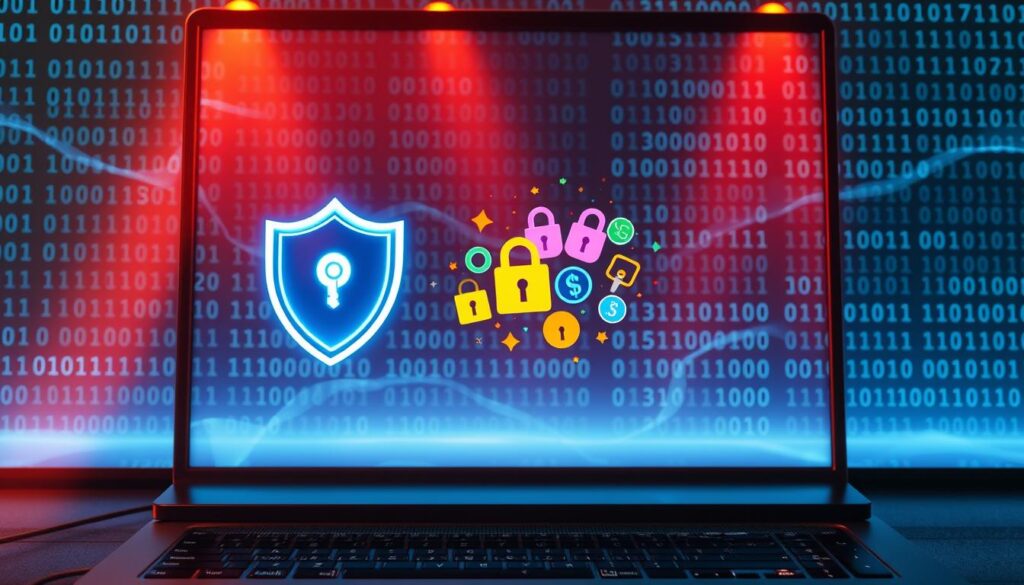This article, from Www.TheComputerTechSquad.com, teaches you about cyber fraud. It shows how to stay safe from it.
In our digital world, being careful online is key. News often talks about online phishing and cybercrimes. It stresses the importance of being alert.
Getting caught in computer scams can lead to big problems. You might lose money or have your personal info stolen. Knowing the risks and protecting yourself online is vital.
Learning about cybercriminals’ tricks helps keep your digital life safe. It keeps you away from cyber fraud.
Understanding Computer Scams
As technology gets better, scammers find new ways to trick people. It’s important to know about computer scams. These scams, like tech support scams and internet scams, are getting smarter. Knowing about scams is key in today’s world.
Computer scams are many and can cause big problems. They can lead to losing money, identity theft, and losing personal data. Tech support scams are common, where scammers pretend to be tech support to get into your computer.
Other scams include phishing, online shopping scams, and spreading malware. Phishing scams trick people into giving out personal info. Online shopping scams make you pay for things that don’t exist.
Types of Computer Scams
- Tech Support Scams
- Phishing Attacks
- Online Shopping Scams
- Malware Distribution
Knowing about these scams is the first step to stay safe. Below is a table that shows the common scams and what they do.
| Scam Type | Description | Common Tactics |
|---|---|---|
| Tech Support Scams | Scammers pretend to be tech support to get into your computer. | Unsolicited calls or pop-ups claiming computer issues. |
| Phishing Attacks | Scammers trick victims into revealing sensitive information. | Fake emails or websites mimicking legitimate services. |
| Online Shopping Scams | Scammers trick people into paying for things that don’t exist. | Fake online stores or sellers on real platforms. |
By knowing about these scams, you can protect yourself. It’s important to stay informed. For more tips on avoiding scams, check out Www.TheComputerTechSquad.com.
The Red Flags of Computer Scams
Scammers are always changing their tricks. But, there are signs that can warn you of danger. Being careful with unexpected messages is key to digital fraud detection. Scammers send out emails, calls, or messages to get your personal info.
One big sign of a scam is an unexpected or unsolicited communication. Real companies usually know your name and explain why they’re contacting you. Scammers, however, use generic greetings and don’t give specific details about your account or transaction.

Scammers try to rush you into acting fast. They might say your account will be suspended or you’ll face legal trouble if you don’t act right away.
To stay safe, know these tricks and pause when you get such messages. Check if the message is real by contacting the company directly.
| Red Flag | Description | Action |
|---|---|---|
| Unsolicited Communication | Emails, calls, or messages from unknown sources asking for personal info. | Verify the sender’s identity through official channels. |
| Pressure Tactics | Threats or urgency to prompt immediate action. | Take time to verify the authenticity of the message. |
| Generic Greetings | Lack of personalization in communications. | Beware of messages that don’t address you by name. |
Knowing these signs and taking steps to protect yourself can really help. Use computer security tips and stay informed to fight computer scams.
Prepared by Www.TheComputerTechSquad.com.
Identifying Phishing Attacks
Online phishing is getting smarter, so it’s important to know how scammers work. They try to trick people into giving away important info like passwords or credit card numbers.
These scams often come through emails, messages, or fake websites. Vigilance is key when you get messages asking for personal info or links that seem off.
To spot phishing attacks, watch for these signs:
- Spelling and grammar mistakes in emails or messages
- Urgent or threatening language to create a sense of panic
- Suspicious sender addresses that don’t match the supposed sender’s domain
- Requests for sensitive information or login credentials
Also, check if websites are secure by looking for HTTPS in the URL. Being cautious when sharing personal info online can help avoid scams.
Experts say knowing the latest phishing tricks is key. Below is a table showing common phishing tactics and how to spot them.
| Phishing Tactic | Description | Red Flags |
|---|---|---|
| Email Phishing | Fraudulent emails that appear to be from a legitimate source | Spelling mistakes, generic greetings |
| Spear Phishing | Targeted phishing attacks on specific individuals or groups | Personalized content, but with malicious intent |
| Smishing | Phishing attacks conducted via SMS or text messages | Urgent or threatening language, suspicious links |
This guide by Www.TheComputerTechSquad.com helps you recognize and dodge phishing scams. It’s all about keeping your online world safe.
The Role of Malware in Scams
Malware is a big threat in the digital world. It’s important to know how it works in scams. Malware is software made to harm or exploit computers. It’s a key part in many computer scams.
There are different types of malware used in scams. These include:
- Viruses: Programs that spread and cause damage or disruption.
- Trojan Horses: Look like real software but let hackers into your system.
- Ransomware: Encrypts your files and demands money to unlock them.
- Spyware: Secretly watches and collects your data, often for bad reasons.
To fight malware, knowing the signs of infection is key. Look out for:
- Slow computer or crashes
- Changes to your system or files without asking
- Strange programs or icons
- Odd network activity
Stopping data breaches and keeping your computer safe needs effort. Here are some computer security tips:
- Update your system and software often.
- Use good antivirus and scan regularly.
- Don’t open emails or attachments from unknown senders.
- Use strong, unique passwords and two-factor authentication.
Understanding malware and how to prevent it can help avoid scams. For more tips on staying safe online, check out Www.TheComputerTechSquad.com.

Good data breach prevention needs tech and safe habits. Back up your data often and be careful with public Wi-Fi. These steps help keep your digital world safe.
Protecting Personal Information
As we use more digital services, keeping personal info safe is key. Cyber threats are getting smarter. So, it’s important for us to protect our data.
Using strong passwords and two-factor authentication (2FA) is a good start. Strong passwords are hard for hackers to guess. Two-factor authentication adds an extra step, like a code sent to your phone, after you enter your password.
“The use of strong passwords and two-factor authentication is a critical step in protecting personal information online. By making these practices a habit, individuals can significantly reduce the risk of falling victim to cyber scams.” –
It’s also important to be careful when sharing personal info online. Watch out for phishing scams. These scams try to trick you into giving away your personal details.
Best Practices for Protecting Personal Information
- Use strong, unique passwords for all accounts.
- Enable two-factor authentication whenever possible.
- Be cautious of unsolicited emails or messages that ask for personal information.
- Regularly update software and operating systems to ensure you have the latest security patches.
Staying up-to-date with cyber threats is also key. Follow trusted sources for the latest on cybersecurity and scam awareness.
| Security Measure | Description | Benefit |
|---|---|---|
| Strong Passwords | Unique and complex passwords | Reduces the risk of unauthorized access |
| Two-Factor Authentication | Additional verification step | Enhances account security |
| Regular Updates | Keeping software up-to-date | Protects against known vulnerabilities |
By following these tips and staying alert, we can better protect ourselves from cyber scams. It’s a team effort that needs constant awareness and learning.

This guide by Www.TheComputerTechSquad.com aims to help people keep their personal info safe in our digital world.
Avoiding Online Shopping Scams
With more people shopping online, it’s important to stay safe. A key computer security tip is to shop on secure websites. Make sure the URL starts with “https” and there’s a lock icon in the address bar.
Online scams can be sneaky, like fake e-commerce sites that steal your info. To dodge these internet scams, research the seller first. Look for reviews and be cautious of sites with few or no feedback.
- Verify the website’s physical address and contact information.
- Be cautious of extremely low prices or “too good to be true” deals.
- Use a credit card or secure payment method for online transactions.
Here’s a comparison of secure vs. insecure shopping sites:
| Feature | Secure Site | Insecure Site |
|---|---|---|
| URL Prefix | https | http |
| Lock Icon | Present | Absent |
| Customer Reviews | Available | Limited or Fake |

Knowing these computer security tips can help you avoid internet scams. Always check if a site is legit before you shop online. Your online security is crucial.
Scams Targeting Seniors
As technology gets better, seniors face more scams. These scams try to trick them because they might have money saved up or are more trusting.
Cyber fraud targeting seniors is a big worry. Scammers keep coming up with new ways to fool them. It’s key for seniors to know about these scams to keep their info safe.
- Phishing scams, where scammers try to get sensitive info via email or phone.
- Investment scams, promising high returns to seniors.
- Romance scams, where scammers pretend to be in a relationship to get money.
To stay safe, seniors should be careful with personal info online or on the phone. It’s important to check who is calling or emailing you.
| Scam Type | Common Tactics | Prevention Tips |
|---|---|---|
| Phishing Scams | Email or phone requests for personal info | Verify sender identity, don’t click on suspicious links |
| Investment Scams | Promises of unusually high returns | Research investment thoroughly, be wary of unsolicited offers |
| Romance Scams | Building a fake online relationship | Be cautious with online relationships, never send money to someone you’ve never met |
This guide by Www.TheComputerTechSquad.com helps seniors stay safe from scams. It teaches them how to avoid cyber fraud.
Reporting Computer Scams
If you find yourself in a computer scam situation, act fast. Reporting it can lessen its harm. It’s key to protect yourself and others from online fraud.
To report a scam, know who to call. In the U.S., the Federal Trade Commission (FTC) or your local consumer agency can help. The FTC has an online form for scam complaints, aiding in fraud detection.
Steps to Report a Computer Scam:
- Document the scam: Save emails, messages, or any other communication.
- Report to the FTC: Use their online complaint assistant.
- Notify your bank: If your financial info was stolen.
- Update your security software: To block more scams.
For more computer security tips, stay updated on scams and how to dodge them. The FTC’s website and cybersecurity blogs are great resources.
| Resource | Description | Contact Information |
|---|---|---|
| Federal Trade Commission (FTC) | Reports scams and provides consumer protection. | FTC Complaint Assistant |
| Local Consumer Protection Agency | Handles local consumer complaints. | Varies by location |
Prepared by Www.TheComputerTechSquad.com, a trusted source for computer security information.
Keeping Your Software Updated
Keeping your software up-to-date is a simple yet powerful step in safeguarding your digital life. Regular updates often include patches for security vulnerabilities that scammers could exploit. By staying current, you significantly reduce the risk of falling victim to cyber scams.
Software updates are essential for data breach prevention. They fix weaknesses in the software that hackers might use to gain unauthorized access to your personal data. Moreover, updates often enhance the overall security features of the software, providing better protection against emerging threats.
To ensure you don’t miss important updates, it’s advisable to set up automatic updates for your operating system and other critical software. This way, you’ll always be protected with the latest security patches without having to manually check for updates.
Benefits of Automatic Updates
- Stay current with the latest security patches
- Reduce the risk of human error by forgetting to update
- Enhance overall computer security
Here is a comparison of manual versus automatic updates:
| Update Method | Reliability | Convenience |
|---|---|---|
| Manual Updates | Dependent on user diligence | Requires constant checking |
| Automatic Updates | Highly reliable | Minimal user effort required |
By adopting automatic updates, you’re following a crucial computer security tip that helps protect your digital environment. This proactive measure, combined with other security practices, significantly enhances your overall digital security posture.
Prepared by Www.TheComputerTechSquad.com, this guide emphasizes the importance of staying updated to prevent data breaches and maintain robust computer security.
Staying Informed About New Scams
To fight cyber threats, knowing the latest scams is key. Follow trusted blogs like Norton and McAfee for insights. They share updates on scammer tactics, keeping you safe from fraud.
Being part of online cybersecurity groups is also smart. These groups share tips and experiences. This way, you can protect yourself and your data from scammers.
Learn more at Www.TheComputerTechSquad.com. It’s your go-to for the latest on cyber threats and how to avoid them. Staying informed is crucial to avoid scams and keep your data safe.


